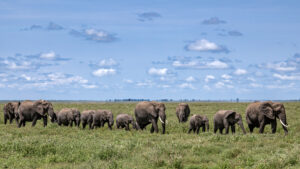Understanding Adventures in Tanzania
Taking a safari has become more popular in the travel industry over the last few years. Experiencing life in the bush, observing wildlife in its habitat, and snapping photos to document the adventure are things modern travelers imagine and have come to expect. However, safari hasn’t always been defined this way. Educating yourself before traveling and understanding African safari history helps enhance your once-in-a-lifetime trip. Here’s a quick overview of rich history.
What’s in a name?
The etymology of the word “safari” goes back to the Arabic verb, “safar,” which means “to journey” or “to travel.” From that comes the noun “safariya” or “journey.” It’s believed that the Swahili word “safari” meaning “long journey,” is a synonym of the Arabic version. The phrase then entered the English language somewhere in the 19th century, credited at the end of the 1850s to British explorer Richard Francis Burton. He gained fame for his explorations in Africa, Asia, and the Americas.
Origins of the African safari
In the beginning, “safari” referred to people’s long journeys for trade routes and migration. In the 1800s, with European colonialism in Africa, the first Europeans headed into the wilderness on massive big game hunting expeditions. During the Victorian era (1837 to 1901), hunting on safari rose in popularity. Aristocratic sportsmen dressed in khaki suits and pith helmets ventured out with a rifle in hand to collect their trophies of large and unusual wildlife. These types of trips led to many animals now being on the endangered list.
In 1836, Major Sir William Cornwallis Harris was among the more notable English travelers. During his trips, he used his artistic skills to illustrate large African fauna, the first to have any claim to accuracy. He also sketched and painted in detail several animals he encountered. He sent his descriptions to the Zoological Society of London.
By the early 20th century, readers who were captivated by works such as Isak Dinesen’s (Danish Baroness Karen Blixen) Out of Africa and American author Ernest Hemingway’s Green Hills of Africa further fueled the desire for exploration and hunting.
In 1909, the Smithsonian Institution outfitted an expedition to Africa led by former President Theodore Roosevelt and his son Kermit. They killed or trapped approximately 11,397 animals for the collection of the then-new Smithsonian Natural History museum.
Transformation for tourists
In the 1920s, a safari would take months and be accomplished by extensive travel via train, steamboat, horses, camels, and mules. But by 1927, the first tourist cars drove into Kruger National Park in South Africa. The African safari business began to boom when 4X4s and early versions of SUVs became more accessible in the late 1950s.
Today’s Tanzania safaris are far from the rough and rugged conditions Hemingway and Roosevelt experienced. Comfortable safari vehicles transport visitors to see The Big 5 in the bush from camps fitted with comfortable beds, clean linens, flushing toilets, hot showers, and chef-prepared meals. You can also get above it all with a hot air balloon.
And while the pith helmet isn’t necessary, and there’s never a specific dress code, wearing khaki or other neutral colors (brown and olive-green) helps travelers blend in with their surroundings. This practice remains as essential today as it did years ago. So, no need to pack fashionable bright colors that make you conspicuous to wildlife or dark blue and black clothing that tends to attract tsetse flies. Forget the rifle, pick up a camera with a long lens, and let the discovery begin.
Wanderful Tanzania can answer any questions you may have about taking an adventure and creating your own African safari history. Contact us today about booking your once-in-a-lifetime experience.



